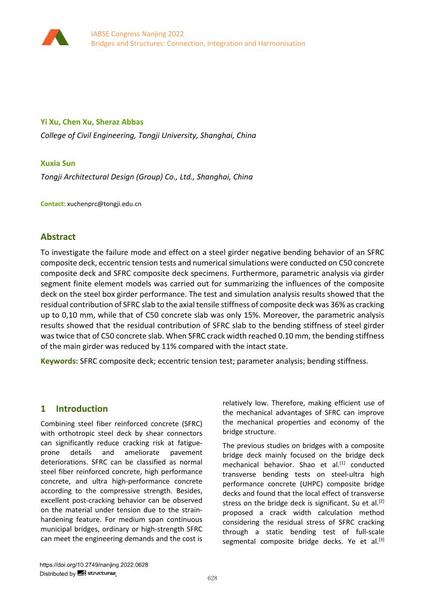Effect of SFRC Composite Deck on Negative Bending Behavior Steel Box Girder

|
|
|||||||||||
Bibliografische Angaben
| Autor(en): |
Yi Xu
(College of Civil Engineering, Tongji University, Shanghai, China)
Chen Xu (College of Civil Engineering, Tongji University, Shanghai, China) Sheraz Abbas (College of Civil Engineering, Tongji University, Shanghai, China) Xuxia Sun (Tongji Architectural Design (Group) Co., Ltd., Shanghai, China) |
||||
|---|---|---|---|---|---|
| Medium: | Tagungsbeitrag | ||||
| Sprache(n): | Englisch | ||||
| Tagung: | IABSE Congress: Bridges and Structures: Connection, Integration and Harmonisation, Nanjing, People's Republic of China, 21-23 September 2022 | ||||
| Veröffentlicht in: | IABSE Congress Nanjing 2022 | ||||
|
|||||
| Seite(n): | 628-636 | ||||
| Anzahl der Seiten (im PDF): | 9 | ||||
| DOI: | 10.2749/nanjing.2022.0628 | ||||
| Abstrakt: |
To investigate the failure mode and effect on a steel girder negative bending behavior of an SFRC composite deck, eccentric tension tests and numerical simulations were conducted on C50 concrete composite deck and SFRC composite deck specimens. Furthermore, parametric analysis via girder segment finite element models was carried out for summarizing the influences of the composite deck on the steel box girder performance. The test and simulation analysis results showed that the residual contribution of SFRC slab to the axial tensile stiffness of composite deck was 36% as cracking up to 0,10 mm, while that of C50 concrete slab was only 15%. Moreover, the parametric analysis results showed that the residual contribution of SFRC slab to the bending stiffness of steel girder was twice that of C50 concrete slab. When SFRC crack width reached 0.10 mm, the bending stiffness of the main girder was reduced by 11% compared with the intact state. |
||||
| Stichwörter: |
Parameteranalyse
|
||||
| Copyright: | © 2022 International Association for Bridge and Structural Engineering (IABSE) | ||||
| Lizenz: | Die Urheberrechte (Copyright) für dieses Werk sind rechtlich geschützt. Es darf nicht ohne die Zustimmung des Autors/der Autorin oder Rechteinhabers/-in weiter benutzt werden. |
||||
